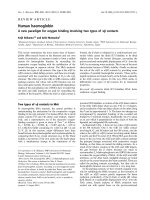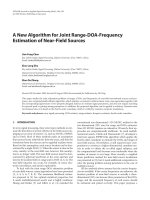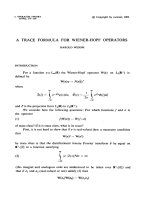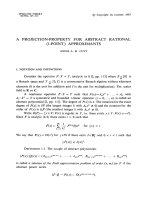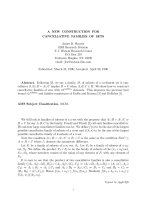Báo cáo toán học: "A stability property for coefficients in Kronecker products of complex Sn characters" ppsx
Bạn đang xem bản rút gọn của tài liệu. Xem và tải ngay bản đầy đủ của tài liệu tại đây (118.2 KB, 8 trang )
A stability property for coefficients in Kronecker
products of complex S
n
characters
Ernesto Vallejo
∗
Universidad Nacional Aut´onoma de M´exico
Instituto de Matem´aticas, Unidad Morelia
Apartado Postal 61-3, Xangari
58089 Morelia, Mich., MEXICO
Submitted: Apr 29, 2009; Accepted: Jun 12, 2009; Published : Jul 2, 2009
Mathematics Subject Classification: 05E10
Abstract
In this note we make explicit a stability property for Kronecker coefficients that
is implicit in a theorem of Y. Dvir. Even in the simplest nontrivial case this property
was overlooked despite of the work of several authors. As applications we give a
new vanish ing result and a new formula for some Kronecker coefficients.
1 Introduction
Let λ, µ, ν be partitions of a positive integer m and let χ
λ
, χ
µ
, χ
ν
be their corresponding
complex irreducible characters of the symmetric group S
m
. It is a long standing problem
to give a satisfactory method for computing the multiplicity
k(λ, µ, ν) := χ
λ
⊗ χ
µ
, χ
ν
(1)
of χ
ν
in the Kronecker product χ
λ
⊗ χ
µ
of χ
λ
and χ
µ
(here ·, · denotes the inner product
of complex characters). Via the Frobenius map, k(λ, µ, ν) is equal to the multiplicity of
the Schur function s
ν
in the internal product of Schur functions s
λ
∗ s
µ
, namely
k(λ, µ, ν) = s
λ
∗ s
µ
, s
ν
,
where ·, · denotes the scalar product of symmetric functions.
The first stability property for Kronecker coefficients was observed by F. Murnaghan
without proof in [8]. This property can be stated in the following way: Let λ, µ, ν
∗
Supported by CONACYT-Mexico, 47086-F a nd UNAM-DGAPA IN103508
the electronic journal of combinatorics 16 (2009), #N22 1
be partitions of a, b, c, respectively. Define λ (n) := (n − a, λ), µ(n) := (n − b, µ),
ν(n) := (n − c, ν). Then the coefficient k(λ(n), µ(n), ν(n)) is constant for all n bigger
than some integer N(λ, µ, ν) . Complete proofs of this property were given by M. Brion [3]
using algebraic geometry and E. Vallejo [13] using combinatorics of Young tableaux. Both
proofs give different lower bounds N(λ, µ, ν) for the stability of k(λ(n), µ(n), ν(n)), for all
partitions λ, µ, ν. C. Ballantine and R. Orellana [1] gave an improvement of o ne of these
lower bounds for a particular case.
Here we make explicit another stability property for Kronecker coefficients that is
implicit in the work of Y. Dvir (Theorem 2.4
′
in [5]). This property can be stated as
follows: Let p, q and r be positive integers such that p = qr. Let λ = (λ
1
, . . . , λ
p
),
µ = (µ
1
, . . . , µ
q
), ν = (ν
1
, . . . , ν
r
) be partitions of some nonnegative integer m satisfying
ℓ(λ) ≤ p, ℓ(µ) ≤ q, ℓ(ν) ≤ r, that is, some parts of λ, µ and ν could be zero. For any
positive integers t and n let (t)
n
denote the vector (t, . . . , t) ∈ N
n
; and for any partition
λ = (λ
1
, . . . , λ
p
) of length at most p let λ + (t)
p
denote the partition (λ
1
+ t, . . . , λ
p
+ t).
Then we have
Theorem 3.1. With the above notation
k(λ, µ, ν) = k(λ + (t)
p
, µ + (rt)
q
, ν + (qt)
r
) .
It should be noted that even in the simplest nontrivial case, when q = 2 = r and
p = 4, this property was overlooked despite of the work of several authors [1, 2, 9, 10].
In this situation Remmel and Whitehead noticed (Theorems 3.1 and 3.2 in [9]) that the
coefficient k(λ, µ , ν) has a much simpler formula if λ
3
= λ
4
. The main theorem provides
an explanation for that. We also obtain a new formula for k(λ, µ, ν) in this case.
This note is organized as follows. Section 2 contains the definitions and notation
about partitions needed in this paper. In Section 3 we give the proof of the main theo-
rem. Section 4 deals with the Kronecker coefficient k(λ, µ, ν) when ℓ(λ) = ℓ(µ)ℓ(ν). In
particular, we give, in this case, a new vanishing condition. Finally, in Section 5 we give
an application of the main theorem.
2 Partitions
In this section we recall the nota t io n about partitions needed in this paper. See for
example [6, 7, 11, 12].
For any nonnegative integer n let [ n ] := {1, . . . , n}. A partition is a vector λ =
(λ
1
, . . . , λ
p
) of nonnegative integers arranged in decreasing order λ
1
≥ · · · ≥ λ
p
. We
consider two partitions equal if they differ by a string of zeros at the end. For example
(3, 2, 1) and (3, 2, 1, 0, 0) represent t he same partition. The length of λ, denoted by ℓ(λ), is
the number of positive parts of λ. The size of λ, denoted by |λ|, is the sum of its parts; if
|λ| = m, we say that λ is a partition of m and denote it by λ ⊢ m. The partition conjugate
to λ is denoted by λ
′
. A composition of m is a vector π = (π
1
, . . . , π
r
) of po sitive integers
such that
r
i=1
π
i
= m.
the electronic journal of combinatorics 16 (2009), #N22 2
The di agram of λ = (λ
1
, . . . , λ
p
), also denoted by λ, is the set of pairs of integers
λ = { (i, j) | i ∈ [ p ], j ∈ [ λ
i
] }.
The identification of λ with its diagram permits us to use set theoretic notation for
partitions. If δ is another part itio n and δ ⊆ λ, we denote by λ/δ the skew diagram
consisting of the pairs in λ that are not in δ, and by |λ/δ| its cardinality. If µ is another
partition, then λ ∩ µ denotes t he set theoretic intersection of λ and µ.
3 Main theorem
3.1 Theorem. Let λ, µ, ν be partitions of some integer m. Let p, q, r be integers such
that p ≥ ℓ(λ), q ≥ ℓ(µ), r ≥ ℓ(ν) and p = qr. Then for any positive integer t we have
k(λ, µ, ν) = k(λ + (t)
p
, µ + (rt)
q
, ν + (qt)
r
) .
The proof of the main theorem will follow from Dvir’s theorem
3.2 Theorem. [5, Theorem 2.4
′
] Let λ, µ, ν be partitions of n such that ℓ(ν) = |λ ∩ µ
′
|.
Let l = ℓ(ν) and ρ = ν − (1
l
). Then
k(λ, µ, ν) = χ
λ/λ∩µ
′
⊗ χ
µ/λ
′
∩µ
, χ
ρ
.
Proof of theorem 3.1. It is enough to prove the theorem for t = 1. The general case
follows by repeated application of the particular case. Let α = λ + (1)
p
, β = µ + (r)
q
and γ = ν + (q)
r
. Then β ∩ γ
′
= (r)
q
. In particular, |β ∩ γ
′
| = p = ℓ(α). So, we have
β/ β ∩ γ
′
= µ and γ/β
′
∩ γ = ν. Thus, by Dvir’s theorem, we have
k(β, γ, α) = k(µ, ν, λ) .
The claim follows from the symmetry k(λ, µ, ν) = k(µ, ν, λ) of Kronecker coefficients.
3.3 Example. To illustrate how Dvir’s theorem applies, let λ = (8, 4), µ = (6, 6) and
ν = (5, 3, 2, 2). Then λ ∩ µ
′
= (2, 2) = λ
′
∩ µ, λ/λ ∩ µ
′
= (6, 2), µ/λ
′
∩ µ = (4, 4) and
ν − (1
4
) = (4, 2, 1, 1). After two applications of Dvir’s theorem we get
k((8, 4), (6, 6), (5, 3, 2, 2)) = k((6, 2), (4, 4), (4, 2, 1, 1))
= k((4), (2, 2), (3, 1)) = 0 .
4 The case ℓ(λ) = ℓ(µ)ℓ(ν)
In this section we give a general result for the Kronecker coefficient k(λ, µ, ν) when ℓ(λ) =
ℓ(µ)ℓ(ν). On the one hand it gives a new vanishing condition. On the other hand, when
this vanishing condition does not hold, it reduces the computation of k(λ, µ, ν) to the
computation of a simpler Kronecker coefficient.
the electronic journal of combinatorics 16 (2009), #N22 3
Let m be a positive integer, λ , µ be partitions of m and π = (π
1
, . . . , π
r
) be a compo-
sition of m. Let ρ(i) ⊢ π
i
for i ∈ [ r ]. A sequence T = (T
1
, . . . , T
r
) of t ableaux is called a
Littlewood-Richardson multitableau of shape λ, content (ρ(1), . . . , ρ(r)) and type π if
(1) there exists a sequence of partitions
∅ = λ(0) ⊂ λ(1) ⊂ · · · ⊂ λ(r) = λ
such that |λ(i)/λ(i − 1)| = π
i
for all i ∈ [ r ], and
(2) T
i
is Littlewood-Richardson tableau of shape λ(i)/λ(i − 1) and content ρ(i), for
all i ∈ [ r ].
For example,
1 1 1 1 1 1 1
1 1 1
2 2 2 2
2
2 2 2
3 3 2 2 3
3
3
is a Littlewood-Richardson multitableau of shape (10, 8, 5, 2), type (10, 8, 7) and content
((4, 4, 2), (3, 3, 2), (3, 3, 1)).
Let LR(λ, µ; π) denote the set of pairs (S, T ) of Littlewood-Richardson multitableaux of
shape (λ, µ ) , same content a nd type π. This means that S = (S
1
, . . . , S
r
) is a Littlewood-
Richardson multitableau of shape λ, T = (T
1
, . . . , T
r
) is a Littlewood- Richardson multi-
tableau of shape µ and both S
i
and T
i
have the same content ρ(i) for some partition ρ(i)
of π
i
, fo r all i ∈ [ r ]. Let c
λ
(ρ(1), ,ρ(r))
denote the number of Littlewood-Richardson multi-
tableaux of shape λ and content (ρ(1), . . . , ρ(r)) and let lr(λ, µ; π) denote the cardinality
of LR(λ, µ; π). Then
lr(λ, µ; π) =
ρ(1)⊢π
1
, ,ρ(r)⊢π
r
c
λ
(ρ(1), ,ρ(r))
c
µ
(ρ(1), ,ρ(r))
.
Similar numbers have already proved to be useful in the study of minimal components,
in the dominance order of partitions, of Kr onecker products [14].
The number lr(λ, µ; π) can be described as an inner product of characters. For this
description we need the permutation character φ
π
:= Ind
S
m
S
π
(1
π
), namely, the induced
character from the trivial character of S
π
= S
π
1
× · · · × S
π
r
. It follows from Frobenius
reciprocity and the Littlewood-Richardson rule that (see also [6, 2.9.17])
4.1 Lemma. Let λ, µ, π be as above. Then
lr(λ, µ; π) = χ
λ
⊗ χ
µ
, φ
π
.
Since Young’s rule and Lemma 4.1 imply that lr(λ, µ; ν) ≥ k(λ, µ, ν), then we have
4.2 Corollary. Let λ, µ, ν be partitions of m. If lr(λ, µ; ν) = 0, then k(λ, µ, ν) = 0.
the electronic journal of combinatorics 16 (2009), #N22 4
4.3 Lemma. Let λ, µ, ν be partitions of m of lengths p, q, r, respectively. If p = qr, and
µ
q
< rλ
p
or ν
r
< qλ
p
, then lr(λ, µ; ν) = 0.
Proof. We assume that lr(λ, µ; ν) > 0 and show that µ
q
≥ rλ
p
and ν
r
≥ qλ
p
. Let (S, T ) be
an element in LR(λ , µ; ν) having content (ρ(1), . . . , ρ(r)). Since T
i
is contained in µ, one
has, by elementary properties of Littlewood-Richardson tableaux, that ℓ(ρ(i)) ≤ ℓ(µ) = q.
For any i, let n
i
be the number of squares of S
i
that are in column λ
p
of λ, then n
i
≤ q.
We conclude that p = n
1
+ · · · + n
r
≤ rq = p. Therefore n
i
= q = ℓ(ρ(i)) for all i. This
forces that each S
i
contains a j in the squares (j + (i − 1)q, 1), . . . , (j + (i − 1)q, λ
p
) of λ,
for all j ∈ [ q ]. So, ρ(i)
j
≥ λ
p
for all j. In particular, for i = r, since S
r
has ν
r
squares,
one has ν
r
≥ qλ
p
. Now, since ℓ(µ) = q, all entries of T
i
equal to q must be in row q of µ.
Then µ
q
≥ ρ(1)
q
+ · · · + ρ(r)
q
≥ rλ
p
. The claim follows.
4.4 Example. To illustrate the idea in the proof of the previous lemma let λ = (8, 5, 4, 3)
and let µ and ν be partitions of 20 length 2. Let (S, T ) be any multitableau in LR(λ, µ; ν).
Then, elementary properties of Littlewood-Richardson tableaux force S to have the form
1 1 1
· · · · ·
2 2 2
· ·
1 1 1
·
2 2 2
Here S = (S
1
, S
2
), S
1
is formed by italic numerals and S
2
by boldface numerals. The
dots indicate entries that can be either in S
1
or S
2
. This par t ia l information on S forces
µ
2
≥ 6 and ν
2
≥ 6.
4.5 Corollary. Let λ, µ, ν be partitions of m of length p, q, r, respectively. If p = qr,
and µ
q
< rλ
p
or ν
r
< qλ
p
, then k(λ, µ, ν) = 0.
Proof. This follows from Lemma 4.3 and Corollary 4.2.
Corollary 4.5 and Theorem 3.1 imply the f ollowing
4.6 Theorem. Let λ, µ, ν be partitions of m of length p, q, r, respectively. Let t = λ
p
and assume p = qr, then we ha v e
(1) I f µ
q
< rt or ν
r
< qt, then k(λ, µ, ν) = 0.
(2) If µ
q
≥ rt and ν
r
≥ qt, let
λ = λ − (t)
p
, µ = µ − (rt)
q
and ν = ν − (qt)
r
. Then,
k(λ, µ, ν) = k(
λ, µ, ν).
5 Applications
We conclude this paper with an application to the expansion of χ
µ
⊗ χ
ν
when ℓ(µ) =
2 = ℓ(ν). It is well known that any component of χ
µ
⊗ χ
ν
corresponds to a partition of
length at most |µ ∩ ν
′
| ≤ 4, see Satz 1 in [4], Theorem 1.6 in [5] or Theorem 2.1 in [9].
the electronic journal of combinatorics 16 (2009), #N22 5
Even in this simple case a nice closed formula seems unlikely to exist. J. Remmel and
T. Whitehead (Theorem 2.1 in [9]) gave a close, though intricate, formula for k(λ, µ , ν)
valid for any λ of length at most 4; M. Ro sas (Theorem 1 in [10]) gave a formula of
combinatorial nature for k(λ, µ, ν), which requires taking subtractions, a lso valid for any
λ of length at most 4; C. Ba llantine and R. Orellana (Proposition 4.12 in [2 ]) gave a
simpler formula for k(λ, µ, ν), at the cost of assuming an extra condition on λ.
Note that when ℓ(λ) = 1 the coefficient k(λ, µ, ν) is trivial t o compute. For ℓ(λ) = 2
the Remmel-Whitehead formula for k(λ, µ, ν) reduces to a simpler one (Theorem 3.3 in
[9]). This formula was recovered by Rosas in a different way (Corollary 1 in [10]). So,
the nontrivial cases are those for which ℓ(λ) = 3, 4. Corollary 5.1 deals with the case
of length 4. On the one hand it gives a new vanishing condition. On the other hand,
when this va nishing condition does not hold, it reduces the case of length 4 to the case of
length 3. Thus, this reduction would help to simplify the proofs of the formulas given by
Remmel-Whitehead and Rosas.
The following corollary is a particular case of Theorem 4.6.
5.1 Corollary. Let λ, µ, ν be a partitions of m of length 4, 2, 2, respectively. Let t = λ
4
,
then we h ave
(1) I f µ
2
< 2t or ν
2
< 2t, then k(λ, µ, ν) = 0.
(2) If µ
2
≥ 2t and ν
2
≥ 2t, let
λ = (λ
1
− t, λ
2
− t, λ
3
− t), µ = (µ
1
− 2t, µ
2
− 2t) and
ν = (ν
1
− 2t, ν
2
− 2t). Then, k(λ, µ, ν) = k(
λ, µ, ν).
Another observation of Remmel and Whitehead (Theorems 3.1 and 3.2 in [9]) is that
their formula simplifies considerably in the case λ
3
= λ
4
. Corollary 5.1 explains this
phenomenon since, in this case, the computation of k(λ, µ, ν) reduces to the computation
of a Kronecker coefficient involving only three partitions of length at most 2, which have
a simple nice formula (Theorem 3.3 in [9]). In fact, combining our result with this simple
formula we obtain a new one. For completeness we record here the Remmel-Whitehead
formula in the equivalent version of Rosas.
In the next theorems the notation (y ≥ x) means 1 if y ≥ x and 0 if y x.
5.2 Theorem. [9, Theorem 3.3] Let λ, µ, ν be partitions of m of length 2. Let x =
max
0,
ν
2
+µ
2
+λ
2
−m
2
and y =
ν
2
+µ
2
−λ
2
+1
2
. Assume ν
2
≤ µ
2
≤ λ
2
. Then
k(λ, µ, ν) = (y − x)(y ≥ x) .
From Corollary 5.1 and Theorem 5.2 we obtain
5.3 Theorem. Let λ, µ, ν be partitions of m of length 4, 2, 2, respectively. Suppose that
λ
3
= λ
4
and that 2λ
3
≤ ν
2
≤ µ
2
. Let x = max
0,
ν
2
+µ
2
+λ
2
−λ
3
−m
2
, y =
ν
2
+λ
2
−µ
2
−λ
3
+1
2
and z =
ν
2
+µ
2
−λ
2
−3λ
3
+1
2
. We have
(1) I f λ
2
+ λ
3
≤ µ
2
, then k(λ, µ, ν) = (y − x)(y ≥ x).
(2) I f λ
2
+ λ
3
> µ
2
, then k(λ, µ, ν) = (z − x)(z ≥ x).
the electronic journal of combinatorics 16 (2009), #N22 6
Proof. Let
λ = (λ
1
− λ
3
, λ
2
− λ
3
), µ = (µ
1
− 2λ
3
, µ
2
− 2λ
3
) and ν = (ν
1
− 2λ
3
, ν
2
− 2λ
3
).
These are partitions of m − 4λ
3
. Then, by Corollary 5.1, k(λ, µ, ν) = k(
λ, µ, ν). Since
ℓ(
λ) = ℓ(µ) = ℓ(ν) = 2, we can apply Theorem 5.2. Due to the symmetry of the
Kronecker coefficients we are assuming ν
2
≤ µ
2
. We have to consider three cases: (a)
λ
2
− λ
3
≤ ν
2
− 2λ
3
, (b) ν
2
− 2λ
3
< λ
2
− λ
3
≤ µ
2
− 2λ
3
and (c) µ
2
− 2λ
3
< λ
2
− λ
3
. In the
first two cases the Remmel-Whitehead formula yields the same formula for k(
λ, µ, ν). So,
we have only two cases to consider: (1) λ
2
+ λ
3
≤ µ
2
and (2) µ
2
< λ
2
+ λ
3
. In the first
case Theorem 5.2 yields
k(
λ, µ, ν) = (y
′
− x
′
)(y
′
≥ x
′
)
where x
′
= max
0,
ν
2
−2λ
3
+λ
2
−λ
3
+µ
2
−2λ
3
−(m−4λ
3
)
2
and y
′
=
ν
2
−2λ
3
+λ
2
−λ
3
−(µ
2
−2λ
3
)+1
2
. It
is straightforward to check that x
′
= x and y
′
= y, so the first claim follows.
The second case is similar.
References
[1] C.M. Ballantine and R.C. Orellana, On the Kronecker product s(n − p, p) ∗ s
λ
, Elec-
tron. J. Combin. 12 (2005) Reseach Paper 28, 26 pp. (electronic).
[2] C.M. Ballantine and R.C. Orellana, A combinatorial interpretation for the coefficients
in the Kronecker product s(n − p, p) ∗ s
λ
, S´em. Lotar. Comb i n. 54A (2006), Art.
B54Af, 29pp. (electronic).
[3] M. Brion, Stable properties of plethysm: on two conjectures of Foulkes, manuscripta
math. 80 (1 993), 347–371.
[4] M. Clausen and H. Meier, Extreme irreduzible Konstituenten in Tensordarstellungen
symmetrischer Gruppen, Bayreuther Math. Schriften 45 (1993), 1–17.
[5] Y. Dvir, On the Kronecker product of S
n
characters, J. Algebra 154 (1 993), 125–140.
[6] G.D. James and A. Kerber, “The representation theory of the symmetric group”,
Encyclopedia of mathematics and its applications, Vol. 16, Addison-Wesley, Reading,
Massachusetts, 1981.
[7] I.G. Macdonald, “Symmetric functions and Hall polynomials,” 2nd. edition Oxfor d
Mathematical Monographs Oxford Univ. Press 1995.
[8] F.D. Murnaghan, The analysis of the Kronecker product of irreducible representa-
tions of the symmetric group, Amer. J. Math. 60 (1938), 76 1–784.
[9] J.B. Remmel and T. Whitehead, On the Kronecker product of Schur functions of two
row shapes, Bull. Belg. Math. Soc. 1 (1 994), 649–683.
[10] M.H. Rosas, The Kronecker product of Schur functions indexed by two-row shapes
or hook shapes, J. Algebraic Combin. 14 (2001), 153– 173.
[11] B. Sagan, “The symmetric group. Representations, combinatorial algorithms and
symmetric functions”. Second ed. Graduate Texts in Mathematics 203. Springer Ver-
lag, 2001.
the electronic journal of combinatorics 16 (2009), #N22 7
[12] R.P. Stanley, “Enumerative Combinatorics, Vol. 2” , Cambridge Studies in Advanced
Mathematics 62. Cambridge Univ. Press, 199 9.
[13] E. Vallejo, Stability of Kronecker product of irreducible characters of the symmetric
group, Electron. J. Combin 6 (1999) Reseach Paper 39, 7 pp. (electronic).
[14] E. Vallejo, Plane partitions and characters of the symmetric group, J. Algebraic
Combin. 11 (2000), 79–88.
the electronic journal of combinatorics 16 (2009), #N22 8
